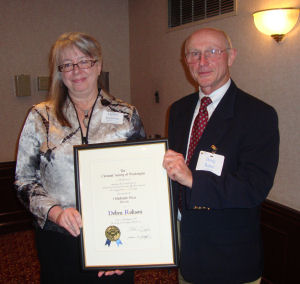Debra Rolison heads the Advanced Electrochemical Materials section at the NRL (also known as the U.S. Navy’s nanoarchitectural firm), where her research focuses on multifunctional nanoarchitectures for rate-critical applications, such as catalysis, energy storage and conversion, and sensors. She received a Ph.D. in Chemistry (UNC–CH, 1980) and is a Fellow of the American Association for the Advancement of Science, the Association for Women in Science, the Materials Research Society (inaugural class), and the American Chemical Society. Rolison received the 2011 ACS Award in the Chemistry of Materials and the 2012 C.N. Reilley Award of the Society for Electroanalytical Chemistry. She is also an Adjunct Professor of Chemistry at the University of Utah (2000–present). When not otherwise bringing the importance of nothing and disorder to materials chemistry, Rolison writes and lectures widely on issues affecting women in science, including proposing Title IX assessments of science and engineering departments. She is the author of over 200 articles and holds 24 patents.
Rewiring electrochemical power from start to finish via architectural design on the nanoscale

Abstract: Designing high-performance energy-storage devices that combine nanometric feature size with well-wired transport paths and that bridge to the macroscale requires an architectural perspective. We use aerogel-like carbon nanofoam papers as our architectural test-bed because they provide a low cost and scalable nanocomposite that offers an optimal balance of critical architectural features: (1) open, 3D interconnected macropores sized at 20-to-250 nm co-continuous with (2) ~20-nm pore walls of a size that reduces dead weight and volume yet retains mechanical strength and flexibility without compromising electronic conductivity. Charge-storage or catalytic functionality can then be imparted to internal carbon walls simply by transporting reactants within the 3D “plumbing” of the macroporous foam. Self-limiting modification strategies allow us to incorporate conformal, nanoscopic functional “paints” of metal(Mn, Ti, Ru, Fe)oxides or polymer (redox-active or electron insulating) or specifically adsorb metal nanoparticles (Pt, Au, Pd, Ag) throughout the macroscopic thickness (0.07 to 0.3 millimeter) of carbon nanofoam papers. For instance, painting the carbon walls with 10-nm MnOx increases the mass-, geometric-, and volume-normalized capacitance (2- to 10-fold) relative to the native carbon nanofoam without significantly altering its high-rate character. The oxide-modified paper is now a multifunctional electrode structure that can be used in an aqueous asymmetric electrochemical capacitor or as an air cathode in a Zn/air cell to electrocatalyze oxygen reduction and provide pulse power. Our redesign of electrode structures using modified carbon nanofoam papers has catalyzed breakthroughs in our work within a broad range of multifunctional energy storage and conversion, including asymmetric electrochemical capacitors, air cathodes for metal–air batteries, 3-D batteries, and semifuel cells.
Read about all past Hillebrand Prize recipients here.



